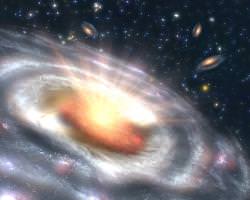Astronomers now believe there are supermassive black holes at the heart of every galaxy. When these black holes are actively feeding on material, they blaze with radiation, visible across the Universe. These active galaxies are known as quasars, and they were thought to be very common in the early Universe. But astronomers were having trouble finding almost any of them. It turns out, they were just hiding.
Supermassive black holes live at the very centre of galaxies, regions that can be thick with gas and dust. As the supermassive black hole goes into its actively feeding stage, the torrents of radiation that pour out collide with the dust. Instead of shining across the Universe, the radiation is smothered by dust.
These black holes are hidden, but they’re not entirely undetectable. Astronomers used NASA’s Spitzer Space Telescope to study 1,000 dusty, massive galaxies known to be furiously making stars. With all this gas and dust tearing around, you would think the supermassive black holes would be actively feeding, and blazing as quasars. But no quasars were seen.
Spitzer’s infrared view, however, allowed astronomers to pierce through the dusty veil surrounding the supermassive black hole, and see that 200 of the galaxies were producing an unusual amount of infrared light. The quasars heat up the dust in the surrounding doughnut cloud, and this cloud gives off the radiation detected by Spitzer.
These quasars are between 9 and 11 billion light-years away. In other words, we see the light they gave off when they were only 2.5 – 4.5 billion years old. Before now, only the rare, extremely energetic quasar was visible – after they had cleared away the surrounding gas and dust. This expanded population gives astronomers a much better understanding of galaxy evolution in the early Universe.
This discovery also downplays the role that galaxy collisions might have had in the early Universe, “theorists thought that mergers between galaxies were required to initiate this quasar activity, but we now see that quasars can be active in unharassed galaxies,” said co-author David Alexander of Durham University, United Kingdom.
The observations were made as part of the Great Observatories Origins Deep Survey, the most sensitive survey to date of the distant universe at multiple wavelengths.
Original Source: NASA News Release

